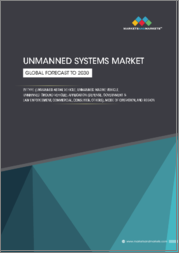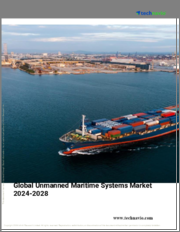
|
시장보고서
상품코드
1541677
세계의 무인정 시장 보고서 : 유형별, 제어 유형별, 용도별, 지역별(2024-2032년)Unmanned Marine Vehicles Market Report by Type (Surface Vehicle, Underwater Vehicle), Control Type (Remotely Operated, Autonomous), Application (Defense, Research, Commercial, and Others), and Region 2024-2032 |
||||||
세계의 무인정 시장 규모는 2023년 44억 달러에 달했습니다. 향후 IMARC Group은 시장이 2032년까지 102억 달러에 이를 전망이고, 예측 기간 동안 9.6%의 복합 연간 성장률(CAGR)을 나타낼 것으로 예측했습니다.
무인정(UMV)이란 인간의 개입 없이 수면상이나 수면하에서 원격조작이나 자동조종이 가능한 로봇 선박 시스템을 말합니다. 표준적인 선박 유형으로는 무인 수상정, 반잠수정, 원격조작,자율형 수중차량 등이 있습니다. 이 군용 시스템은 소형 선박에서 중형 선박에 이르기까지 주변 지역의 환경 관련 데이터를 수집하고 기록하고 차량의 반응과 진로를 평가하는 데 도움이되는 여러 센서를 갖추고 있습니다. UMV는 해양 동물 모니터링 개선, 군사 관련 위험한 작업의 자동 실행, 안전성 제공, 최소 운영 비용으로 조사 기간 단축 등에 유용합니다. 또한 UMV는 안정성과 조종성이 우수하기 때문에 해양학과 수로학 데이터 수집, 심해 채굴, 대잠수함전(ASW) 등의 용도로 사용되고 있습니다.
무인정 시장 동향
군수부문의 해군,국방부문에서의 급속한 확대와 정보,감시,정찰(ISR) 활동을 위한 자율형 수중,원격조작선박(AUVs/ROVs)에 대한 요구의 고조가 주로 시장 성장의 원동력과 되어 있습니다. 또한 어뢰 위험, 수중 기뢰, 디젤 전기 잠수함 공격, 단거리 대함 미사일 등 해양 안보 위협에 대처하기 위해 각국 정부의 방위군에 대한 대규모 투자가 또 하나 성장 촉진요인으로 작용하고 있습니다. 이에 따라 선박의 안전한 항행을 위한 해도 작성과 항만 개척을 위한 담수환경 파악을 위한 수로조사에 있어서의 자율형 해상차량의 보급이 시장의 성장을 지지하고 있습니다. 또한 수중 네비게이션 시스템, 안정화 무기 솔루션, 적외선 비전을 사용하여 수중 환경을 모니터링하는 전기 광학 추적 장치와 UMV의 대규모 통합이 시장 성장을 가속하고 있습니다. 이와는 별도로 잠재적인 수중 위협을 무력화하기 위한 주요 기업들이 로봇 플랫폼을 개척하는 것은 시장 성장을 적극적으로 추진하고 있습니다.
이 보고서에서 다루는 주요 질문
- 세계의 무인정 시장은 지금까지 어떻게 추이하고 향후 어떻게 추이할 것인가?
- COVID-19는 세계의 무인정 시장에 어떤 영향을 미쳤는가?
- 주요 지역 시장은?
- 유형별 시장 분석은?
- 제어 유형별 시장 분석은?
- 용도별 시장 분석은?
- 업계의 밸류체인의 다양한 단계는?
- 업계의 주요 촉진요인과 도전은 무엇인가?
- 세계의 무인정 시장의 구조와 주요 진출기업은?
- 업계 경쟁도는?
목차
제1장 서문
제2장 조사 범위와 조사 방법
- 조사의 목적
- 이해관계자
- 데이터 소스
- 1차 정보
- 2차 정보
- 시장 추정
- 상향식 접근
- 하향식 접근
- 조사 방법
제3장 주요 요약
제4장 소개
- 개요
- 주요 업계 동향
제5장 세계의 무인정 시장
- 시장 개요
- 시장 실적
- COVID-19의 영향
- 시장 예측
제6장 시장 분석 : 유형별
- 수상
- 수중
제7장 시장 분석 : 제어유형별
- 원격조작형
- 자율형
제8장 시장 분석 : 용도별
- 방어
- 연구
- 상용
- 기타
제9장 시장 분석 : 지역별
- 북미
- 미국
- 캐나다
- 아시아태평양
- 중국
- 일본
- 인도
- 한국
- 호주
- 인도네시아
- 기타
- 유럽
- 독일
- 프랑스
- 영국
- 이탈리아
- 스페인
- 러시아
- 기타
- 라틴아메리카
- 브라질
- 멕시코
- 기타
- 중동 및 아프리카
- 시장 동향
- 시장 분석 : 국가별
- 시장 예측
제10장 SWOT 분석
- 개요
- 강점
- 약점
- 기회
- 위협
제11장 밸류체인 분석
제12장 Porter's Five Forces 분석
- 개요
- 구매자의 협상력
- 공급기업의 협상력
- 경쟁도
- 신규 참가업체의 위협
- 대체품의 위협
제13장 가격 분석
제14장 경쟁 구도
- 시장 구조
- 주요 기업
- 주요 기업 프로파일
- Atlas Elektronik GmbH(ThyssenKrupp AG)
- Fugro
- General Dynamics Mission Systems Inc.(General Dynamics Corporation)
- Kongsberg Gruppen
- L3harris Technologies Inc.
- Lockheed Martin Corporation
- QinetiQ
- Rafael Advanced Defense Systems Ltd.
- Saab AB
- Teledyne Technologies Inc.
- Textron Inc.
- The Boeing Company
The global unmanned marine vehicles market size reached US$ 4.4 Billion in 2023. Looking forward, IMARC Group expects the market to reach US$ 10.2 Billion by 2032, exhibiting a growth rate (CAGR) of 9.6% during 2024-2032.
Unmanned marine vehicles (UMVs) refer to robotic vessel systems that can be operated above and below the water surface remotely or automatically without any human intervention. It includes unmanned surface craft, semi-submersibles, and remotely operated and autonomous underwater vehicles as some standard vessel types. These military systems can range from small vessels to mid-sized ships, and they are equipped with several sensors that help acquire and record environment-related data of nearby areas and assess vehicle response or course. UMVs assist in improving marine animal monitoring, performing risky military-related tasks automatically, offering safety, and reducing survey duration at minimal operational costs. Apart from this, UMVs are stable and maneuverable; therefore, they are used in oceanographic or hydrographic data collection, deep-sea mining, and anti-submarine warfare (ASW) applications.
Unmanned Marine Vehicles Market Trends:
The rapid expansion in the navy and defense department of the military sector and the increasing need for autonomous underwater and remotely operated vehicles (AUVs/ROVs) for intelligence, surveillance, and reconnaissance (ISR) operations are primarily driving the market growth. Additionally, extensive investments by governments in defense forces to deal with maritime-security threats, such as torpedo dangers, underwater mines, diesel-electric submarine attacks, and short-range anti-ship missiles, are acting as another growth-inducing factor. In line with this, the widespread uptake of autonomous marine vehicles in hydrographic surveys to produce navigational charts for safer transit of vessels and understand the freshwater environment for port and harbor development is supporting the market growth. Moreover, the large-scale integration of UMVs with underwater navigation systems, stabilized weapon solutions, and electro-optical tracking devices to monitor the aquatic environment using infrared vision is propelling the market growth. Apart from this, the development of robotic platforms by key players to neutralize potential underwater threats are positively augmenting the market growth.
Key Market Segmentation:
IMARC Group provides an analysis of the key trends in each sub-segment of the global unmanned marine vehicles market report, along with forecasts at the global, regional and country level from 2024-2032. Our report has categorized the market based on type, control type and application.
Breakup by Type:
Surface Vehicle
Underwater Vehicle
Breakup by Control Type:
Remotely Operated
Autonomous
Breakup by Application:
Defense
Research
Commercial
Others
Breakup by Region:
North America
United States
Canada
Asia-Pacific
China
Japan
India
South Korea
Australia
Indonesia
Others
Europe
Germany
France
United Kingdom
Italy
Spain
Russia
Others
Latin America
Brazil
Mexico
Others
Middle East and Africa
Competitive Landscape:
The competitive landscape of the industry has also been examined along with the profiles of the key players being Atlas Elektronik GmbH (ThyssenKrupp AG), Fugro, General Dynamics Mission Systems Inc. (General Dynamics Corporation), Kongsberg Gruppen, L3harris Technologies Inc., Lockheed Martin Corporation, QinetiQ, Rafael Advanced Defense Systems Ltd., Saab AB, Teledyne Technologies Inc., Textron Inc. and The Boeing Company.
Key Questions Answered in This Report:
- How has the global unmanned marine vehicles market performed so far and how will it perform in the coming years?
- What has been the impact of COVID-19 on the global unmanned marine vehicles market?
- What are the key regional markets?
- What is the breakup of the market based on the type?
- What is the breakup of the market based on the control type?
- What is the breakup of the market based on the application?
- What are the various stages in the value chain of the industry?
- What are the key driving factors and challenges in the industry?
- What is the structure of the global unmanned marine vehicles market and who are the key players?
- What is the degree of competition in the industry?
Table of Contents
1 Preface
2 Scope and Methodology
- 2.1 Objectives of the Study
- 2.2 Stakeholders
- 2.3 Data Sources
- 2.3.1 Primary Sources
- 2.3.2 Secondary Sources
- 2.4 Market Estimation
- 2.4.1 Bottom-Up Approach
- 2.4.2 Top-Down Approach
- 2.5 Forecasting Methodology
3 Executive Summary
4 Introduction
- 4.1 Overview
- 4.2 Key Industry Trends
5 Global Unmanned Marine Vehicles Market
- 5.1 Market Overview
- 5.2 Market Performance
- 5.3 Impact of COVID-19
- 5.4 Market Forecast
6 Market Breakup by Type
- 6.1 Surface Vehicle
- 6.1.1 Market Trends
- 6.1.2 Market Forecast
- 6.2 Underwater Vehicle
- 6.2.1 Market Trends
- 6.2.2 Market Forecast
7 Market Breakup by Control Type
- 7.1 Remotely Operated
- 7.1.1 Market Trends
- 7.1.2 Market Forecast
- 7.2 Autonomous
- 7.2.1 Market Trends
- 7.2.2 Market Forecast
8 Market Breakup by Application
- 8.1 Defense
- 8.1.1 Market Trends
- 8.1.2 Market Forecast
- 8.2 Research
- 8.2.1 Market Trends
- 8.2.2 Market Forecast
- 8.3 Commercial
- 8.3.1 Market Trends
- 8.3.2 Market Forecast
- 8.4 Others
- 8.4.1 Market Trends
- 8.4.2 Market Forecast
9 Market Breakup by Region
- 9.1 North America
- 9.1.1 United States
- 9.1.1.1 Market Trends
- 9.1.1.2 Market Forecast
- 9.1.2 Canada
- 9.1.2.1 Market Trends
- 9.1.2.2 Market Forecast
- 9.1.1 United States
- 9.2 Asia-Pacific
- 9.2.1 China
- 9.2.1.1 Market Trends
- 9.2.1.2 Market Forecast
- 9.2.2 Japan
- 9.2.2.1 Market Trends
- 9.2.2.2 Market Forecast
- 9.2.3 India
- 9.2.3.1 Market Trends
- 9.2.3.2 Market Forecast
- 9.2.4 South Korea
- 9.2.4.1 Market Trends
- 9.2.4.2 Market Forecast
- 9.2.5 Australia
- 9.2.5.1 Market Trends
- 9.2.5.2 Market Forecast
- 9.2.6 Indonesia
- 9.2.6.1 Market Trends
- 9.2.6.2 Market Forecast
- 9.2.7 Others
- 9.2.7.1 Market Trends
- 9.2.7.2 Market Forecast
- 9.2.1 China
- 9.3 Europe
- 9.3.1 Germany
- 9.3.1.1 Market Trends
- 9.3.1.2 Market Forecast
- 9.3.2 France
- 9.3.2.1 Market Trends
- 9.3.2.2 Market Forecast
- 9.3.3 United Kingdom
- 9.3.3.1 Market Trends
- 9.3.3.2 Market Forecast
- 9.3.4 Italy
- 9.3.4.1 Market Trends
- 9.3.4.2 Market Forecast
- 9.3.5 Spain
- 9.3.5.1 Market Trends
- 9.3.5.2 Market Forecast
- 9.3.6 Russia
- 9.3.6.1 Market Trends
- 9.3.6.2 Market Forecast
- 9.3.7 Others
- 9.3.7.1 Market Trends
- 9.3.7.2 Market Forecast
- 9.3.1 Germany
- 9.4 Latin America
- 9.4.1 Brazil
- 9.4.1.1 Market Trends
- 9.4.1.2 Market Forecast
- 9.4.2 Mexico
- 9.4.2.1 Market Trends
- 9.4.2.2 Market Forecast
- 9.4.3 Others
- 9.4.3.1 Market Trends
- 9.4.3.2 Market Forecast
- 9.4.1 Brazil
- 9.5 Middle East and Africa
- 9.5.1 Market Trends
- 9.5.2 Market Breakup by Country
- 9.5.3 Market Forecast
10 SWOT Analysis
- 10.1 Overview
- 10.2 Strengths
- 10.3 Weaknesses
- 10.4 Opportunities
- 10.5 Threats
11 Value Chain Analysis
12 Porters Five Forces Analysis
- 12.1 Overview
- 12.2 Bargaining Power of Buyers
- 12.3 Bargaining Power of Suppliers
- 12.4 Degree of Competition
- 12.5 Threat of New Entrants
- 12.6 Threat of Substitutes
13 Price Analysis
14 Competitive Landscape
- 14.1 Market Structure
- 14.2 Key Players
- 14.3 Profiles of Key Players
- 14.3.1 Atlas Elektronik GmbH (ThyssenKrupp AG)
- 14.3.1.1 Company Overview
- 14.3.1.2 Product Portfolio
- 14.3.2 Fugro
- 14.3.2.1 Company Overview
- 14.3.2.2 Product Portfolio
- 14.3.2.3 Financials
- 14.3.2.4 SWOT Analysis
- 14.3.3 General Dynamics Mission Systems Inc. (General Dynamics Corporation)
- 14.3.3.1 Company Overview
- 14.3.3.2 Product Portfolio
- 14.3.4 Kongsberg Gruppen
- 14.3.4.1 Company Overview
- 14.3.4.2 Product Portfolio
- 14.3.4.3 Financials
- 14.3.5 L3harris Technologies Inc.
- 14.3.5.1 Company Overview
- 14.3.5.2 Product Portfolio
- 14.3.5.3 Financials
- 14.3.6 Lockheed Martin Corporation
- 14.3.6.1 Company Overview
- 14.3.6.2 Product Portfolio
- 14.3.6.3 Financials
- 14.3.6.4 SWOT Analysis
- 14.3.7 QinetiQ
- 14.3.7.1 Company Overview
- 14.3.7.2 Product Portfolio
- 14.3.7.3 Financials
- 14.3.8 Rafael Advanced Defense Systems Ltd.
- 14.3.8.1 Company Overview
- 14.3.8.2 Product Portfolio
- 14.3.9 Saab AB
- 14.3.9.1 Company Overview
- 14.3.9.2 Product Portfolio
- 14.3.9.3 Financials
- 14.3.9.4 SWOT Analysis
- 14.3.10 Teledyne Technologies Inc.
- 14.3.10.1 Company Overview
- 14.3.10.2 Product Portfolio
- 14.3.10.3 Financials
- 14.3.10.4 SWOT Analysis
- 14.3.11 Textron Inc.
- 14.3.11.1 Company Overview
- 14.3.11.2 Product Portfolio
- 14.3.11.3 Financials
- 14.3.11.4 SWOT Analysis
- 14.3.12 The Boeing Company
- 14.3.12.1 Company Overview
- 14.3.12.2 Product Portfolio
- 14.3.12.3 Financials
- 14.3.12.4 SWOT Analysis
- 14.3.1 Atlas Elektronik GmbH (ThyssenKrupp AG)













